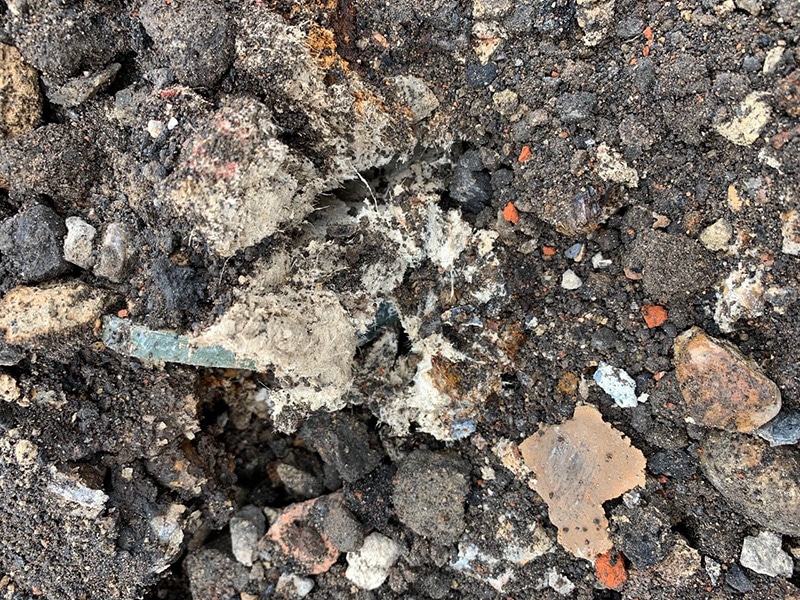Can I bury asbestos on my own land?
Undisturbed asbestos doesn’t usually present a danger. However, if the asbestos is damaged and microscopic fibres release, people in the area could unknowingly inhale them. Asbestos exposure becomes particularly dangerous when those fibres get stuck to a person’s lung tissue.
A number of health issues can result from asbestos exposure, and they may not show up for 20, 30, 40, or more years. Conditions like asbestosis, lung cancer, mesothelioma, and pleural thickening can occur. They’re often untreatable and even fatal.
Asbestos carries an incredibly high health risk. That’s why it’s important to properly dispose of asbestos-containing materials (ACMs). Those working with ACMs and people in the vicinity should follow the proper precautions to avoid inhaling any fibres. Additionally, all ACMs must be disposed of so there’s no chance of coming into contact with the asbestos following cleanup.
Laws and regulations on asbestos disposal
There are many regulations about asbestos. They cover all sorts of topics. For example, the duty holder responsible for managing asbestos on a property, how to remove asbestos, and how to dispose of it.
What laws and regulations govern asbestos and its disposal?
The Control of Asbestos Regulations 2012 govern how asbestos is managed, worked with, and disposed of.
According to the Health and Safety Executive (HSE), asbestos waste “must be placed in suitable packaging to prevent any fibres being released.” The waste should be double-wrapped and labelled. (Note that asbestos waste refers to ACMs that are ready for disposal.)
The best way to do this is to first wrap the waste in a red bag and then put asbestos warning labels on it. Next, wrap the waste again in a clear bag with labels showing there’s hazardous material inside.
For waste that cannot fit into a bag, the HSE says not to break it up, which could cause fibres to be released. Instead, these types of ACMs can be double-wrapped with 1,000-gauge polythene sheeting. They should also have appropriate labelling.
The HSE also states, “Asbestos waste should only be handled by a licenced disposal site.” During transit to that site, the asbestos has to be properly cared for so it doesn’t release fibres. Find out more about asbestos disposal from the HSE’s Disposal of Asbestos Waste PDF.
What are the penalties for violating asbestos disposal laws?
If you violate asbestos laws, you could face a hefty fine and even imprisonment for as long as 24 months. There are numerous news reports about businesses paying fines for the improper handling of asbestos. For example, an unlicenced asbestos removal company was fined £80k for operating unlawfully. There was also a UK retailer that was fined £565k for not following the duty to manage asbestos.
Can you bury asbestos on your own land?
There are some types of asbestos that are less prone to damage when compared to more fibrous asbestos products. Yet, even if you feel comfortable handling certain kinds of ACMs, that doesn’t make them safe to bury.
You may think that burying asbestos on your own property is a smart way to safely dispose of it. What if the soil is ever disturbed, though? Whether it’s now or in the future, anybody in the area could inhale dangerous asbestos fibres.
Also, were it to be discovered that you’d buried asbestos on your property and you were reported, this could lead to serious legal problems for you.
What are the risks and dangers of burying asbestos?
It is not safe to bury asbestos anywhere (other than in a landfill), including on your own land. Burying asbestos in a farm, garden, or public land puts anyone in the area at risk if the asbestos is disturbed.
Burying asbestos means that land will be considered contaminated. This poses a health risk to you and anyone on the property. Selling the property in the future will also be difficult.
What are the consequences of burying asbestos on your own land?
The UK prohibits burying asbestos waste. Ignoring this regulation could lead to fines and/or imprisonment. Fines can be as high as £20,000, and in some cases, they’ve been even more costly. Also, you can get up to two years in jail for disobeying asbestos rules and regulations.
On top of that, if your property is classified as contaminated, you may have an almost impossible time selling it. Mortgage lenders typically won’t lend for a property that’s been deemed contaminated or that has hazardous waste on it.
It’s possible you’ll end up with people interested in buying your property despite the presence of asbestos. They may not be able to get a loan for it, though.
How to dispose of asbestos properly
Some types of asbestos are more difficult to handle than others because they’re so easily damaged. But no matter what type of ACM you’re dealing with, it’s necessary to dispose of it properly. Otherwise, you could put your own health in danger, and you could also contaminate the area where you choose to dispose of it. That’s why you can’t simply get rid of asbestos by burying it in your backyard.
Hire a professional asbestos removal company
Only a licenced asbestos removal company should handle ACMs. Your first step is to contact an accredited asbestos specialist to identify the type of asbestos you have for disposal. The specialist will then be able to tell you how to properly dispose of the asbestos waste.
Dispose of asbestos-containing materials at an approved landfill
Usually, ACMs are disposed of in landfills. However, the UK has a few different types of landfills, and each one can only handle certain types of materials. How the waste will behave in a landfill determines which type of landfill it can be put in. You’ll need a specialist to advise you on where the asbestos waste can be safely disposed of.
What are the guidelines for handling and transporting ACMs?
The duty holder (the person responsible for managing the property’s asbestos) must “prevent escape of the waste whilst it is in their control,” according to the HSE.
When it comes to handling and transporting asbestos, different types of asbestos waste have varying amounts of risk. For example, asbestos drain pipes are not as dangerous to transport as fibrous asbestos waste like thermal insulation. That’s because thermal insulation is more prone to breakage, which is what releases the dangerous fibres.
The type of asbestos being handled and transported determines its packaging and labelling. Only a licenced contractor should handle and transport ACMs and asbestos waste.
Wrapping up: The dangers of burying asbestos on your own land
When you bury asbestos on your own land, you contaminate the land. That means that anyone who’s on or even near the land, whether it’s you, your family, or future property owners, could potentially damage the asbestos. If asbestos fibres are released, they could cause serious and life-threatening health conditions decades later. Asbestos fibres are nearly impossible to detect a lot of the time, so you may not even realise that you’re in danger.
Following proper asbestos disposal regulations is about more than saving you from paying large fines or facing jail time. It’s also about keeping you and everyone around you safe. From handling asbestos to disposing of it properly in the correct type of landfill, it’s the duty holder’s responsibility to limit exposure risk as much as possible.
It’s never a good idea to work with asbestos on your own. Contact a professional today who understands asbestos laws and knows how to work with ACMs and asbestos waste.

Written by Callum McDonald
Callum McDonald is an expert in asbestos quality management, ensuring rigorous adherence to regulations and high-quality standards in removal projects. His focus on enhancing quality and client satisfaction makes him a crucial asset in safety and compliance within the field. Callum's expertise in technical support and oversight of licensed works underscores his commitment to excellence in asbestos management, providing invaluable guidance to clients in this specialised area.

